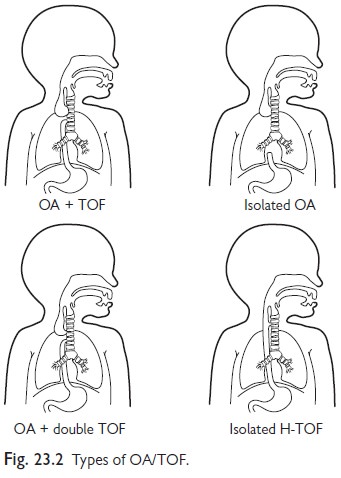Chapter: Paediatrics: Paediatric Surgery
Paediatrics: Congenital abnormalities: tracheo-oesophageal
Congenital abnormalities: tracheo-oesophageal
Tracheo-oesophageal fistula
TOF is usually associated with OA.
However, an isolated TOF will pre-sent with:
ŌĆó
choking
or coughing during feeding;
ŌĆó
abdominal
distension;
ŌĆó
recurrent
LRTI.
Although symptoms are present from
birth the diagnosis is frequently not made until later in childhood. The
investigations of choice are a tube injec-tion of X-ray contrast into the
oesophagus and bronchoscopy. Treatment is surgical division of the TOF through
a neck incision.
Oesophageal atresia and tracheo-oesophageal fistula
The incidence of OA and TOF (Fig.
23.2) is 1/3500 live births.
ŌĆó
75%
babies with OA will have a TOF.
ŌĆó
10%
will have isolated OA, which is usually associated with a long gap or defect.
ŌĆó
Rare
isolated TOF.
ŌĆó
Rare
OA with both upper and lower pouch TOFs.

Maternal polyhydramnios is common,
although antenatal diagnosis is rare.
Babies present at birth with:
ŌĆó
excess
mucus or ŌĆśmucousyŌĆÖ;
ŌĆó
choking
and cyanosis on feeding;
ŌĆó
associated
malformations in 50%, usually the VACTERL association.
Diagnosis
Confirmed or excluded by:
ŌĆó
Passage
of a 10F NGT.
ŌĆó
CXR: the tube stops in the upper
thorax. Air in the stomach indicates a
fistula between the trachea and the distal oesophagus (TOF).
Acute management
ŌĆó
The
baby should be kept warm and disturbed as little as possible.
ŌĆó
The
upper oesophageal pouch should be aspirated regularly by oropharyngeal suction
or a Replogle tube.
ŌĆó
Standard
IV fluids started.
ŌĆó
Pre-operative
antibiotics are not required unless there is evidence of aspiration pneumonia.
ŌĆó
Babies
who require mechanical ventilation must be referred urgently for surgery
because gas will escape down the TOF and produce progressive gastric
distension, which impairs ventilation further, ultimately leading to gastric
perforation.
Surgery
ŌĆó
Disconnection
of the TOF and anastomosis of upper and lower oesophagus through a right
thoracotomy.
ŌĆó
Long
gap OA may require a feeding gastrostomy and a cervical oesophagostomy in the
neonatal period followed by oesophageal replacement during infancy. Some
specialist centres now perform the Foker operation, where prolonged internal
ŌĆśstretchŌĆÖ makes the remnant of the upper and lower oesophagus ŌĆśgrowŌĆÖ!
ŌĆó
High-risk
babies may have a staged procedureŌĆöthe TOF is ligated and then the OA repaired
a few days later.
ŌĆó
Complications
include anastomotic leak, anastomotic stricture, gastro-oesophageal, and
recurrent fistula.
Follow-up
ŌĆó
Respiratory
morbidity in the early years after OA/TOF repair is relatively high,
particularly in the winter months. Consider admitting these children during
respiratory infections.
ŌĆó
Obstruction
of the oesophagus by food boluses is common in toddlers and young children
after OA repair. Usually, it is caused by meat that has not been chewed. Refer
for urgent oesophagoscopy.
Related Topics